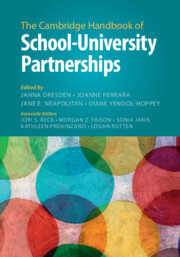Book contents
- The Cambridge Handbook of School–University Partnerships
- The Cambridge Handbook of School–University Partnerships
- Copyright page
- Contents
- Figures
- Tables
- Contributors
- Foreword
- Preface
- Acknowledgments
- Part I The History and Conceptual Foundations of School–University Partnerships
- Part II Teachers and Learning to Teach in School–University Partnerships
- Introduction to Part II: Teachers and Learning to Teach in School–University Partnerships
- 10 Love Letters and Freedom Dreams
- 11 Community as Classroom
- 12 Making Space for Teacher Agency
- 13 Centering the Complex Role of School-Based Teacher Educators in Professional Development Schools
- 14 Teacher Candidate Supervision as Praxis
- 15 Developing a Responsive Framework in School–University Partnerships
- 16 Commentary: School–University Partnerships
- 17 Commentary: Teachers and Learning to Teach in School–University Partnerships
- Part III Equity and Student Learning in School–University Partnerships
- Part IV Leadership in School–University Partnerships
- Part V Community Schools as School–University Partnerships
- Part VI Inquiry and Innovation in School–University Partnerships
- Part VII Funding, Policy, and the Politics of School–University Partnerships
- Part VIII Looking at School–University Partnerships across Geographic and Cultural Borders
- Index
- References
15 - Developing a Responsive Framework in School–University Partnerships
from Part II - Teachers and Learning to Teach in School–University Partnerships
Published online by Cambridge University Press: 05 November 2025
- The Cambridge Handbook of School–University Partnerships
- The Cambridge Handbook of School–University Partnerships
- Copyright page
- Contents
- Figures
- Tables
- Contributors
- Foreword
- Preface
- Acknowledgments
- Part I The History and Conceptual Foundations of School–University Partnerships
- Part II Teachers and Learning to Teach in School–University Partnerships
- Introduction to Part II: Teachers and Learning to Teach in School–University Partnerships
- 10 Love Letters and Freedom Dreams
- 11 Community as Classroom
- 12 Making Space for Teacher Agency
- 13 Centering the Complex Role of School-Based Teacher Educators in Professional Development Schools
- 14 Teacher Candidate Supervision as Praxis
- 15 Developing a Responsive Framework in School–University Partnerships
- 16 Commentary: School–University Partnerships
- 17 Commentary: Teachers and Learning to Teach in School–University Partnerships
- Part III Equity and Student Learning in School–University Partnerships
- Part IV Leadership in School–University Partnerships
- Part V Community Schools as School–University Partnerships
- Part VI Inquiry and Innovation in School–University Partnerships
- Part VII Funding, Policy, and the Politics of School–University Partnerships
- Part VIII Looking at School–University Partnerships across Geographic and Cultural Borders
- Index
- References
Summary
Schools and universities have a long history of collaboration to address educational goals, but at present these partnerships find themselves at a crossroads navigating myriad contextual factors influencing both teacher education and PK-12 schools. In reviewing the evolution of the Mason Elementary PDS program, as well as the historical phases of School–University partnerships (Catelli, 2021), we identified partnership elements and ultimately designed a program framework that facilitated responsiveness in challenging times. Through examples, we demonstrate how our framework sustains partnership efforts in our context. In closing we recommend school and universities create supporting frameworks for adapting flexibly in their unique settings.
Keywords
Information
- Type
- Chapter
- Information
- The Cambridge Handbook of School–University Partnerships , pp. 251 - 271Publisher: Cambridge University PressPrint publication year: 2025
References
Accessibility standard: WCAG 2.1 AA
Why this information is here
This section outlines the accessibility features of this content - including support for screen readers, full keyboard navigation and high-contrast display options. This may not be relevant for you.Accessibility Information
Content Navigation
Allows you to navigate directly to chapters, sections, or non‐text items through a linked table of contents, reducing the need for extensive scrolling.
Provides an interactive index, letting you go straight to where a term or subject appears in the text without manual searching.
Reading Order & Textual Equivalents
You will encounter all content (including footnotes, captions, etc.) in a clear, sequential flow, making it easier to follow with assistive tools like screen readers.
Visual Accessibility
You will still understand key ideas or prompts without relying solely on colour, which is especially helpful if you have colour vision deficiencies.
Structural and Technical Features
You gain clarity from ARIA (Accessible Rich Internet Applications) roles and attributes, as they help assistive technologies interpret how each part of the content functions.
